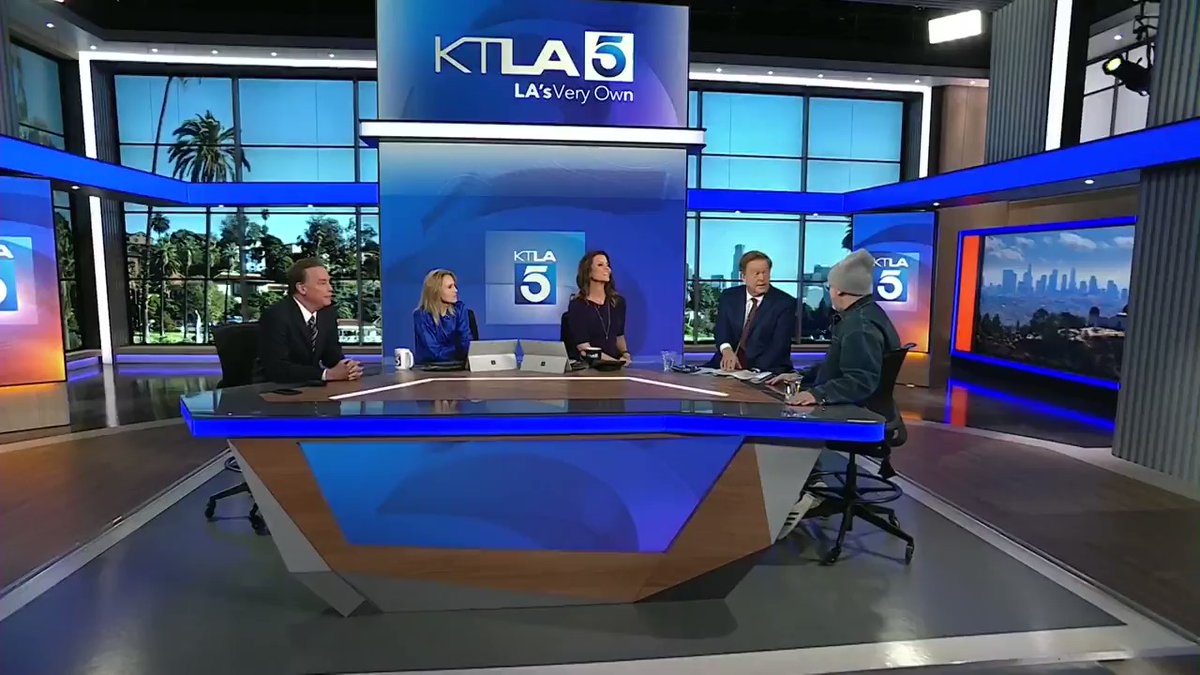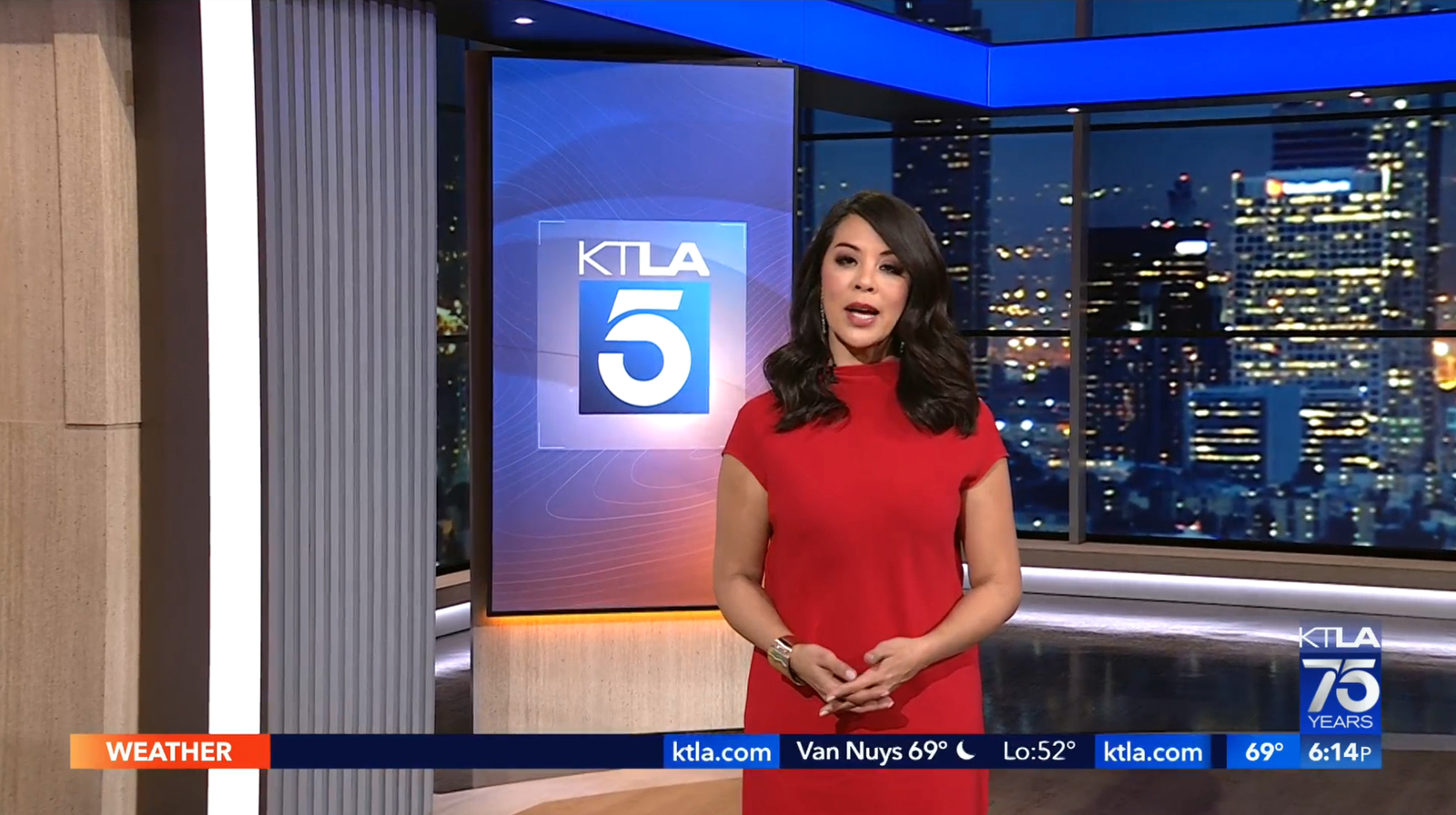KTLA’s new home blends region’s diverse architectural, natural looks

Subscribe to NCS for the latest news, project case studies and product announcements in broadcast technology, creative design and engineering delivered to your inbox.
Los Angeles’ Nexstar-owned CW affiliate, KTLA, has debuted a sprawling new set designed to embody SoCal while also giving its news team more opportunities to interact, tell stories and have conversations.
KTLA management opted to go with Los Angeles-based set designer JHD Group – led by Jeff Hall – for the project.
Hall called the year-long collaboration a “truly” team effort. “The entire team at KTLA and Nexstar were tremendous partners throughout the design and build process,” he said.
Hall centered the design for KTLA on the primary anchor area, which is placed in front of what is designed to look like a wall of floor-to-ceiling windows with that quintessential million-dollar view so sought after in the region.
The wall is actually created using 86-inch Philips video panels with structural mullions and can be fed with a variety of images depicting sweeping views of the region at different times of the day.

While it’s easy to envision this wall of windows being inside of a celeb’s hilltop mansion, there’s no attempt here to make it feel like you’ve been transported into a home — it’s still decidedly a news set, which feels appropriate for a station that’s known for its distinct, local news-heavy schedule.
For example, allusions to a Hollywood home pretty much end thanks to a seamless Neoti LED video tower that bisects the wall of faux windows.
This 11-foot high tower of LED, which is placed forward of the digital window wall, is created using two distinct segments. A lower portion off the wall is relatively square and serves as the primary visual in anchor shots and can include branding along with topical graphics.
A separate segment above an internally lit horizontal band soars to the ceiling and is clearly designed as a header element — something that had been a prominent element on several of the previous iterations of the station’s set. Before, however, that header was static scenery, so switching to LED allows the station to change out the logo or imagery here almost instantly.
Overall, the element is bold in proportions and gives the station the ability to create a variety of looks behind its anchors.
The anchor area is smartly framed out with a series of nested internally-lit structural elements that flow up from the floor and over the anchor desk below, which draws the eye in thanks to its nods to the concepts of forced perspective and vanishing point.

These strong right angles are another theme integrated throughout the current set — and a motif the station’s previous sets have used heavily, including squares inspired by the station’s logo footprint.
Tucked in between these arched elements are lighting instruments that, while also serving a practical purpose, also become part of the set’s homages to the region.
Anchors now sit around a desk with an edge-lit element atop a surprising look — a sort of low-poly base that manages to feel clean and modern and organic at the same time while channeling the look of the region’s steep geological features.
Camera left features a small extension of the floor-to-ceiling window look along with a freestanding vertically-mounted video panel designed to be positioned closer to the cameras.
The opposite wall features a similar vertical panel placed a bit farther back in the corner, which leaves room for a seamless video wall that can be used as a far camera-right one shot background.
The desk is fronted with high res Neoti LED and sits on a subtle riser with a sharp edge. A smaller rectangular segment riser that lands roughly midway between the floor and anchor desk level is placed off-center to the camera right side.

JHD positioned a trio of swivel-mounted 86-inch Philips panels set inside strong angular structures in front of a light blonde wood-toned wall. This transitions into an opening in the scenery — two sliding frosted panels with Asian and craftsman-influenced latticework with a video wall behind it.

Here again, while the panels have a hint of being something one might find in a high-end home, the look is complemented by the high-tech background they obscure and sprawling scale to tilt the look more toward that of a news set. In some ways, the generous spacing here also hints at AR-fueled looks.
Next to this area is a curved sculptural wall created using a series of strong verticals with integrated lighting set against rich wood textures. This wall is hinged and serves as a way to disguise a load-in point for the set, which sits inside one of the historic Warner Bros. soundstages, which is part of the reason behind its sprawling layout.

Continuing around the studio, there is a brief break in the scenery that’s essentially the set’s “fourth wall” before transitioning to a different type of scenery.
First is a floor-to-ceiling green wall filled with faux plants set inside of a variety of cubby-hole-like alcoves framed out with light wood. The greenery’s rich color is offset by blank spaces, which have the added benefit of adding depth and shadows to the look.
This narrow wall is primarily designed for more informal, one-on-one interviews done using stools, but also serves as as a shoot-off for the neighboring space, which continues the geometric cubby motif but sans the greens.
This flexible area can be used for demonstrations, performances or living room-style setups and features a video panel for topical imagery with a large iteration of the station’s logo above. There’s an additional segment of greenery before the set transitions into another entry point.
Where the other entry with the sliding panels is wide, this one is vertical and features another nod to craftsman design with a blocky screen background set in front of a dramatically lit flat wall. This entrance to the set has a unique feature — going through it and turning slightly to the right provides direct access to the station’s outdoor patio-style space that is set up for TV production.
This placement allows for a single-shot transition from indoors to outdoors, something that wasn’t possible before.

Filling out the space between the doorway and anchor area, meanwhile, is a 12-foot by 7-foot Neoti LED wall designed primarily for weather — the station has eliminated the use of chroma key in the studio but notably did not add a working weather center to the set.
Another hallmark of the set is the ability to cross-shoot between venues. Because the set wraps nearly a full 360 degrees, the options for toss and interaction shots between areas are extensive. JHD and the lighting team plotted out numerous types of these shots, giving the station a wide variety of looks and transitional elements to pick from.
There are also shots that purposefully give viewers glimpses at the robotic cameras, a nod to a previous set’s riser with railing placed closer to the fourth wall.

While KTLA’s graphics package remains the same, the station did create new looks specifically for the on-set video panels.
Dominating this look is a blue background with a subtly-shaded oversized 3D version of the station’s iconic “5” logo. The design manages to convey the sense of the number while also hinting at waves of water or a blue sky with wisps of clouds.
Moving in closer, the design features a series of concentric organic shapes that could be read as isobars, bathymetry lines or the contours of topographical maps, all of which are elements in the region’s nature.
By default, the station’s logo is displayed in a frosted square prominently between anchors. The use of the square offset with the curved elements blends many of the same visual language elements found in the set and other parts of the station’s look.
Project Credits
Scenic Design – JHD Group
Jeff Hall – Principal Designer
Caron Alcoser – Senior Art Director
Grant Van Zevern – Designer/ Illustration Art Director
Amelia Bransky – Drafting
Greg Arther – Project Director
Fabrication – IDF Studio Scenery
Lighting Design – KTLA
Integrated Scenic LED – InPhase
AV Integration – Digital Video Group
Alex Martin – Principal
Kevin Filano – Project Manager
Brad Spangler – Lead Integrator
LED – Neoti
Additional project support by FX Design Group.
Subscribe to NCS for the latest news, project case studies and product announcements in broadcast technology, creative design and engineering delivered to your inbox.






tags
Digital Video Group, IDF Studio Scenery, InPhase, jeff hall, JHD Group, KTLA, Neoti, Nexstar, Nexstar Media Group
categories
Broadcast Industry News, Heroes, Local News, News Set Design, Set Design